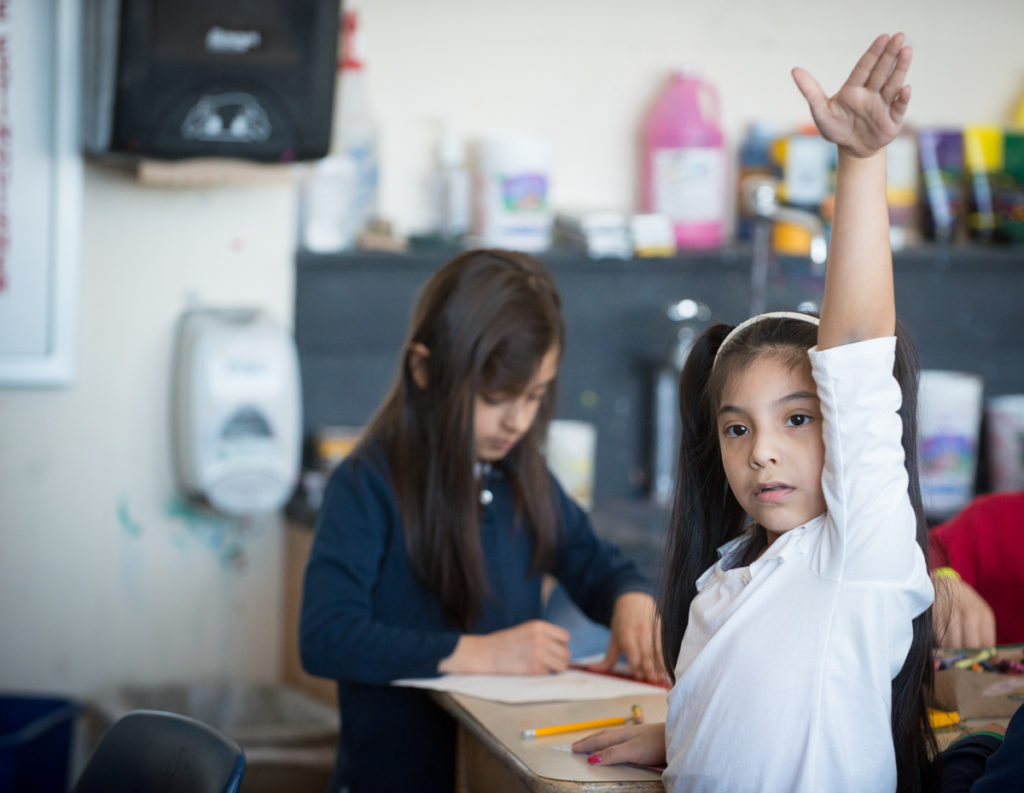
Recently, more than a handful of my first graders were struggling with waiting to ask questions or make comments during direct instruction. I responded by using tried and true teacher practices: giving a clear signal (shaking my head no) to let the child know this was not an appropriate time, or simply saying “Ben, put your hand down. I’ll ask for questions and comments soon.” But the behavior did not stop. Instead, I found myself feeling exasperated when, one minute into the very next lesson, the same hands would go up when I was in the middle of talking.
Then I received an advance copy of the new Responsive Classroom book The Language of Learning: Teaching Students Core Thinking, Listening, & Speaking Skills. I was excited to read it. Flipping through, I saw the section called “Waiting Until the Speaker Has Completely Finished,” and started reading. A very bright light bulb went off over my head, as I realized that yes, there is a better way to deal with this new frustrating behavior: teach and model the skills needed using an Interactive Modeling lesson with an embedded think-aloud. Genius!
I tried it the next day. After gathering students on the carpet, I began by saying: “Lately, many of you have been raising your hands before I finish giving directions or while I am teaching. In this classroom, our rules say to be respectful and have our bodies in control. When you raise your hands before someone is finished speaking, it can feel disrespectful. It can also distract you from listening to what is being said because you are busy trying to remember your own thought or question.” I explained that we were going to work on waiting until the speaker is finished and that I was going to show them how to do it.
Then I used Interactive Modeling to demonstrate while they observed, thinking aloud to make what I was doing visible to the children. My think-aloud sounded something like this:
“I have a question right now for Mrs. Roberts. But, wait, she hasn’t finished giving directions. I should wait because it isn’t respectful to put my hand up yet. She might even answer my question by the time she’s done, so I better tune in to her words right now. I can put my hand up at the end.”
After we named and noticed the specific language and actions I used, I had students demonstrate the skill. Then everyone practiced. At the end of the lesson, which took about ten minutes, I stated my expectations for the future by explaining that “today and every day, when I am teaching or giving directions, I want you to try to remember to save your questions and comments for an appropriate time. We’ll keep working together on this, and I am excited to see how you do!”
So far, it seems to have made a difference. The think-aloud part of the lesson helped my students see and hear why holding onto their thoughts is important, and the Interactive Modeling helped them practice the skill while receiving feedback from peers and myself. Since then, students have been displaying more self-control and respectful listening during lessons, and I am feeling less frustrated.
Plus, I’ve now read the rest of The Language of Learning, and it’s amazing! This is a book I’ll turn to whenever I’m looking for specific ideas to help my students develop speaking and listening skills. I love the timeline for teaching speaking and listening skills, the Common Core tables correlating skills discussed in the book with the Speaking and Listening Standards, and the “Quick Guide” for using the techniques described. I look forward to continuing to use this terrific resource this year and beyond!
“Here’s the guidebook for educators . . . to help students develop and hone those foundational skills that are precursors to accessing virtually all learning opportunities in school—and in life.”
— Carol Ann Tomlinson
Language of Learning
Candace Roberts is a Responsive Classroom consultant, kindergarten teacher in Rhode Island, and Early Childhood Generalist.